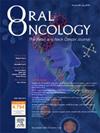Predicting outcomes in head and neck surgery with modified frailty index and surgical apgar scores
IF 4
2区 医学
Q1 DENTISTRY, ORAL SURGERY & MEDICINE
引用次数: 0
Abstract
Objective
To compare the efficacy of the Modified Frailty Index and Modified Surgical Apgar scores in predicting postoperative outcomes in head and neck cancer patients.
Methods
We retrospectively reviewed patients who underwent major head and neck surgery between 2012 and 2015. Modified Surgical Apgar, and Frailty Index, scores were calculated on 723 patients. The primary outcome was 30-day complication and/or mortality.
Results
The mean Modified Frailty Index was 0.11 ± 0.12, and mean Modified Surgical Apgar score was 6.15 ± 1.67. Both scores were significantly associated with 30-day complication (P<0.05). The Modified Surgical Apgar score was superior to the Modified Frailty Index in predicting complications (Area Under the Curve (AUC) = 0.76; 95 % Confidence Interval (CI), 0.722–0.793; and AUC=0.59; 95 % CI, 0.548–0.633, respectively). Concurrent use of both scoring systems (AUC=0.77) was not superior to individual use. An increase in the mFI from 0.27 to 0.36 was associated with an increase in the risk of complication postoperatively (Odds Ratio (OR) = 3.67; 95 % CI, 1.30–10.34, P=.014). A reduction in the mSAS from 7 to 6 increased the risk of complication following surgery (OR=2.64; 95 % CI, 1.45–4.80; P=.002).
Conclusion
Both scores are useful in risk stratifying head and neck cancer patients. The Modified Surgical Apgar score was superior at predicting complications; concurrent use of both scores added minimal benefit.
用改良虚弱指数和手术 apgar 评分预测头颈部手术的结果
目的比较改良虚弱指数和改良手术阿普加评分在预测头颈部癌症患者术后预后方面的效果。 方法我们回顾性地分析了 2012 年至 2015 年间接受头颈部大手术的患者。计算了723名患者的改良手术阿普加评分和虚弱指数。结果改良虚弱指数的平均值为 0.11 ± 0.12,改良手术 Apgar 评分的平均值为 6.15 ± 1.67。两项评分均与 30 天并发症有明显相关性(P<0.05)。改良外科 Apgar 评分在预测并发症方面优于改良虚弱指数(曲线下面积 (AUC) = 0.76; 95 % 置信区间 (CI), 0.722-0.793; 和 AUC=0.59; 95 % CI, 0.548-0.633)。同时使用两种评分系统(AUC=0.77)并不优于单独使用。mFI 从 0.27 增加到 0.36 与术后并发症风险的增加有关(Odds Ratio (OR) = 3.67; 95 % CI, 1.30-10.34, P=0.014)。mSAS从7降至6会增加术后并发症的风险(OR=2.64;95 % CI,1.45-4.80;P=.002)。改良手术阿普加评分在预测并发症方面更胜一筹;同时使用两种评分的益处微乎其微。
本文章由计算机程序翻译,如有差异,请以英文原文为准。
求助全文
约1分钟内获得全文
求助全文
来源期刊

Oral oncology
医学-牙科与口腔外科
CiteScore
8.70
自引率
10.40%
发文量
505
审稿时长
20 days
期刊介绍:
Oral Oncology is an international interdisciplinary journal which publishes high quality original research, clinical trials and review articles, editorials, and commentaries relating to the etiopathogenesis, epidemiology, prevention, clinical features, diagnosis, treatment and management of patients with neoplasms in the head and neck.
Oral Oncology is of interest to head and neck surgeons, radiation and medical oncologists, maxillo-facial surgeons, oto-rhino-laryngologists, plastic surgeons, pathologists, scientists, oral medical specialists, special care dentists, dental care professionals, general dental practitioners, public health physicians, palliative care physicians, nurses, radiologists, radiographers, dieticians, occupational therapists, speech and language therapists, nutritionists, clinical and health psychologists and counselors, professionals in end of life care, as well as others interested in these fields.
 求助内容:
求助内容: 应助结果提醒方式:
应助结果提醒方式:


